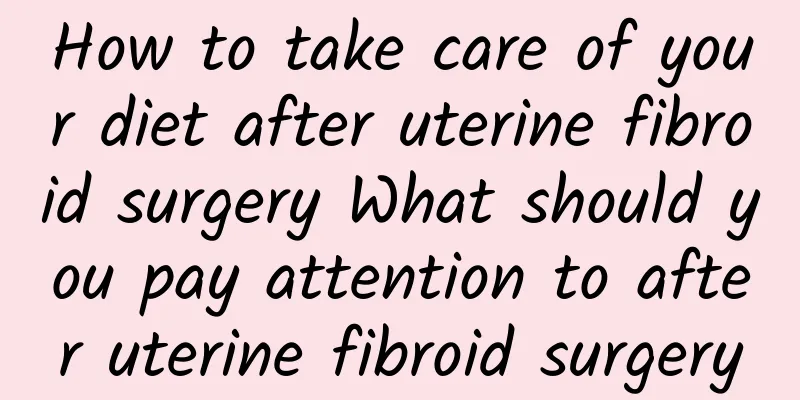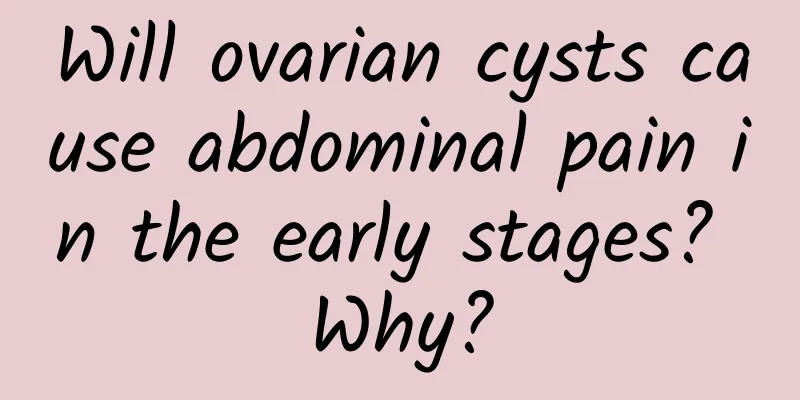How to take care of your diet after uterine fibroid surgery What should you pay attention to after uterine fibroid surgery

|
The main things to note after minimally invasive surgery for uterine fibroids are: 1. Carefully take care of the surgical wound: After uterine fibroid surgery, the patient's surgical wound is usually at the navel, about 1 cm long. Keep the wound clean and dry after surgery, and do not scratch the wound at will. The wound usually heals ten days after surgery. During this period, avoid getting the wound wet by showering. 2. Develop regular daily living habits: After uterine fibroid surgery, patients need to get enough rest and eat a light diet to help with recovery. If the recovery is good, patients can resume their normal work and rest routine within 7 days after surgery. Patients who like to stay up late and have irregular work and rest routines should be strict with themselves after surgery and develop a healthy and reasonable work and rest schedule for themselves. 3. Moderate exercise: Usually patients recover well 50 days after uterine fibroid surgery. According to their physical condition, they can choose the right exercise for themselves and persist in exercising to help improve their physical fitness. The diet after minimally invasive surgery for uterine fibroids should also be taken care of. For example, patients with uterine fibroids should eat light meals and it is best not to eat mutton, dog meat, shrimp, crab, eel, salted fish, black fish and other hair-raising foods. Patients with uterine fibroids can eat more seaweed foods, such as laver, kelp, cabbage, wakame, etc. Seaweed contains the most minerals such as calcium, iron, sodium, magnesium, phosphorus, and iodine. Modern science believes that eating seaweed foods regularly can effectively regulate blood pH and prevent excessive consumption of alkaline elements (calcium and zinc) in the body due to acid neutralization. Maintain a low-fat diet and eat more lean meat, chicken, eggs, quail eggs, crucian carp, turtle, white fish, cabbage, asparagus, celery, spinach, cucumber, winter melon, mushrooms, tofu, kelp, seaweed, fruits and other cool vegetables and fruits. What kind of diet should be taken after minimally invasive surgery for uterine fibroids? Which foods are more suitable for recovery? Patients with uterine fibroids should eat light meals and it is best not to eat irritating foods such as mutton, dog meat, shrimp, crab, eel, salted fish, and black fish. 2. Patients with uterine fibroids should eat more whole grains such as corn and beans, and can also eat some nutritious dried fruits such as peanuts, sesame seeds, melon seeds, etc. In addition, daily tea and rice should be quantified on time to prevent overeating. 3. Eat more lean meat, chicken, eggs, quail eggs, crucian carp, turtle, white fish, cabbage, asparagus, celery, spinach, cucumber, winter melon, mushrooms, tofu, kelp, seaweed, fruits and other cold dishes and fruits. 4. Patients with uterine fibroids can eat more seaweed foods, such as laver, kelp, cabbage, wakame vegetables, etc. Seaweed contains the most minerals such as calcium, iron, sodium, magnesium, phosphorus, iodine, etc. Modern science believes that regular consumption of seaweed foods can effectively regulate blood pH and avoid excessive consumption of alkaline elements (calcium and zinc) in the body due to acid neutralization. How long you need to rest after uterine fibroid surgery varies. Because traditional uterine fibroid surgery is harmful to women's bodies, you need to rest for a long time after surgery to recover. Traditional uterine fibroid surgery requires at least two weeks of rest. Full recovery takes two to three months. For patients who choose minimally invasive surgery to treat uterine fibroids, they usually stay in the hospital for 2-3 days, rest for 1-2 weeks, and fully recover in about 1-2 months. The specific rest method after uterine fibroid surgery is related to the patient's physical condition. |
Recommend
How should female friends take preventive measures against dysmenorrhea?
How should female friends take preventive measure...
Experts analyze the causes of vulvar leukoplakia
According to medical evidence, vulvar leukoplakia...
What is the reason for menstruation to come ten days early?
Coming your period ten days early may be a minor ...
Drinking yogurt on an empty stomach to lose weight may cause gastroesophageal reflux
If you want to lose weight by "cleansing you...
Will you lose weight if you get enough sleep? Kaile lost 10 kg by eating this way and got rid of the nickname "Swallowtail Butterfly"
Kaile (Sister Butterfly), who has been in the ent...
What are the common causes of cervical erosion?
Cervical erosion is the most common disease among...
Correct prevention measures for cervical hypertrophy
Cervical hypertrophy is a common cervical disease...
Prevention methods after abortion
After an abortion, the endometrium of a woman is ...
Can pelvic inflammatory disease heal on its own?
Pelvic inflammatory disease generally does not he...
Cervical precancerous lesions
Cervical precancerous lesions refer to lesions th...
What are the abnormal symptoms after uterine fibroid surgery?
Uterine fibroids are the most common gynecologica...
Does cervical hypertrophy require surgery? What are the precautions for cervical hypertrophy surgery?
Whether or not to have surgery for cervical hyper...
What causes ectopic pregnancy?
Ectopic pregnancy is a very difficult disease. Th...
Sichuan style original weight loss method, first reduce belly fat with these 4 tricks and lose 5 kg!
When did you start caring so much about losing we...
What are the causes of irregular menstruation?
There are many reasons for irregular menstruation...









